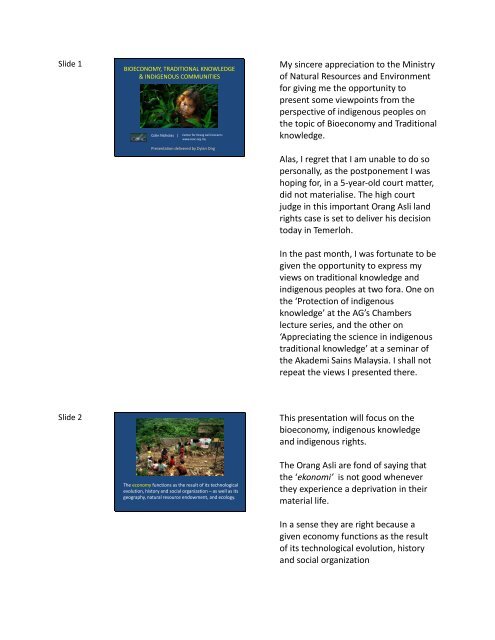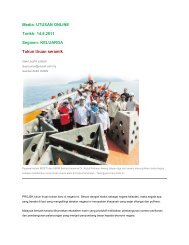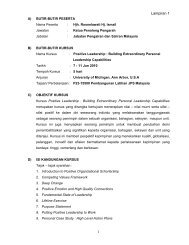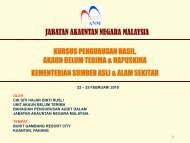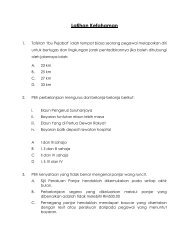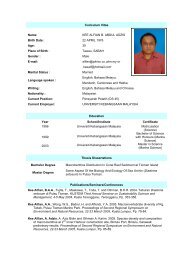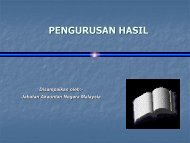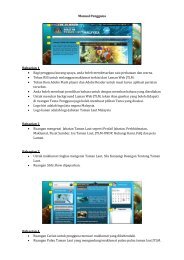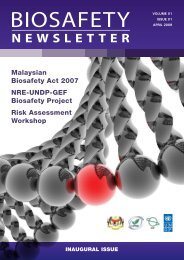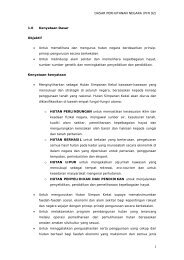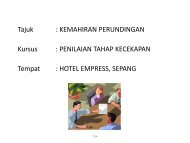My sincere appreciation to the Ministry of Natural Resources ... - NRE
My sincere appreciation to the Ministry of Natural Resources ... - NRE
My sincere appreciation to the Ministry of Natural Resources ... - NRE
Create successful ePaper yourself
Turn your PDF publications into a flip-book with our unique Google optimized e-Paper software.
Slide 7What is Indigenous/Traditional Knowledge?These sophisticated sets <strong>of</strong>understandings, interpretationsand means are part and parcel <strong>of</strong> acultural complex thatencompasses language, namingand classification systems,resource use practices, ritual,spirituality and worldview.These sophisticated sets <strong>of</strong>understandings, interpretations andmeans are part and parcel <strong>of</strong> a culturalcomplex that encompasses language,naming and classification systems,resource use practices, ritual,spirituality and worldview.Slide 8Traditional knowledgeincludes expressions <strong>of</strong>cultural values, beliefs,rituals and communitylaws, and knowledgeregarding land andecosystemmanagement.Also, in <strong>the</strong> context <strong>of</strong> indigenouspeoples such as <strong>the</strong> Orang Asli,traditional knowledge generally meanstraditional practices and culture and<strong>the</strong> knowledge <strong>of</strong> plants and animalsand <strong>of</strong> <strong>the</strong>ir methods <strong>of</strong> propagation.It includes: expressions <strong>of</strong> culturalvalues, beliefs, rituals and communitylaws, and knowledge regarding landand ecosystem management.Generally, however, this knowledge isnot documented, but transmittedorally.
Slide 9Oral Tradition, a Collective KnowledgeOrang Asli oral tradition is <strong>the</strong>reforecollective knowledge. Such collectiveknowledge invariably translates in<strong>to</strong> <strong>the</strong>culture <strong>of</strong> a people.Oral Tradition is a collective knowledge, which translatesin<strong>to</strong> <strong>the</strong> culture <strong>of</strong> a people.It has been argued quite widely thatOrang Asli collective knowledge, ascontained in <strong>the</strong>ir oral tradition, is <strong>the</strong>foundation on which members obtain<strong>the</strong>ir sense <strong>of</strong> community, personalidentity, and ancestral anchorage.Slide 10Indigenous knowledge includes oral traditionand cultural heritageHowever, Orang Asli indigenousknowledge is not limited <strong>to</strong> justmedicinal plants.Ra<strong>the</strong>r, what constitutes indigenousknowledge includes Orang Asli oraltradition and Orang Asli culturalheritage.Slide 11UN Special Rapporteur onDiscrimination AgainstIndigenous Peoples:Protection <strong>of</strong> <strong>the</strong> Heritage<strong>of</strong> Indigenous People, Erica-Irene Daes (UNESCO 1995),The heritage <strong>of</strong> indigenous peoples is comprised <strong>of</strong> allobjects, sites and knowledge <strong>the</strong> nature or use <strong>of</strong> whichhas been transmitted from generation <strong>to</strong> generation,and which is regarded as pertaining <strong>to</strong> a particularpeople or its terri<strong>to</strong>ry.According <strong>to</strong> <strong>the</strong> UN Special Rapporteuron Discrimination Against IndigenousPeoples,The heritage <strong>of</strong> indigenous peoples iscomprised <strong>of</strong> all objects, sites andknowledge <strong>the</strong> nature or use <strong>of</strong> whichhas been transmitted from generation<strong>to</strong> generation, and which is regarded aspertaining <strong>to</strong> a particular people or itsterri<strong>to</strong>ry.
Slide 12International instruments that protect Traditional KnowledgeInternational InstrumentProvisionThe Universal Declaration <strong>of</strong> Human Rights Article 27The International Covenant on Economic, Social and CulturalArticle 15, paragraph 1 (c)RightsThe International Covenant on Civil and Political Rights Article 27The Convention on Biological DiversityArticle 8 (j)The International Labour Organisation Convention No.169concerning Indigenous and Tribal Peoples in Independent Articles 13, 15, 23CountriesAgenda 21 Paragraph 26.1The Rio Declaration on Environment and Development Principle 22The UN Declaration on <strong>the</strong> Rights <strong>of</strong> Indigenous Peoples Articles 11 and 31The Aichi Targets <strong>of</strong> <strong>the</strong> CBD Target 18Perhaps because <strong>of</strong> <strong>the</strong> growinginterest in indigenous traditionalknowledge, especially for <strong>the</strong> newbioeconomy, that <strong>the</strong>re are nowactually several ‘protections’ affordedby international instruments, includingthose which Malaysia has alreadysigned or ratified.The table shows <strong>the</strong> Majorinternational instruments thatrecognize Indigenous peoples’ right <strong>to</strong>protect <strong>the</strong>ir traditional knowledgeSlide 13UNDRIP Article 31, paragraph 1Indigenous peoples have <strong>the</strong> right <strong>to</strong> maintain,control, protect and develop <strong>the</strong>ir culturalheritage, traditional knowledge and traditionalcultural expressions, as well as <strong>the</strong>manifestations <strong>of</strong> <strong>the</strong>ir sciences, technologiesand cultures, including human and geneticresources, seeds, medicines, knowledge <strong>of</strong> <strong>the</strong>properties <strong>of</strong> fauna and flora, oral traditions,literatures, designs, sports and traditional gamesand visual and performing arts.They also have <strong>the</strong> right <strong>to</strong> maintain, control,protect, and develop <strong>the</strong>ir intellectual propertyover such cultural heritage, traditionalknowledge, and traditional cultural expressions.More specifically, <strong>the</strong> United NationsDeclaration on <strong>the</strong> Rights <strong>of</strong> IndigenousPeoples (UNDRIP) draws on o<strong>the</strong>r majorinstruments <strong>to</strong> provide <strong>the</strong> mostexplicit recognition internationally <strong>of</strong>Indigenous people’s rights <strong>to</strong> <strong>the</strong>irtraditional knowledge. Article 31 reads:Indigenous peoples have <strong>the</strong> right <strong>to</strong>maintain, control, protect and develop<strong>the</strong>ir cultural heritage, traditionalknowledge and traditional culturalexpressions, as well as <strong>the</strong>manifestations <strong>of</strong> <strong>the</strong>ir sciences,technologies and cultures, includinghuman and genetic resources, seeds,medicines, knowledge <strong>of</strong> <strong>the</strong> properties<strong>of</strong> fauna and flora, oral traditions,literatures, designs, sports andtraditional games and visual andperforming arts.They also have <strong>the</strong> right <strong>to</strong> maintain,control, protect, and develop <strong>the</strong>irintellectual property over such culturalheritage, traditional knowledge, andtraditional cultural expressions.
Slide 14Convention on BiologicalDiversity , Article 8j…respect, preserve and maintainknowledge, innovations and practices<strong>of</strong> Indigenous and local communitiesembodying traditional lifestylesrelevant for <strong>the</strong> conservation andsustainable use <strong>of</strong> biological diversityand promote <strong>the</strong>ir wider applicationwith <strong>the</strong> approval and involvement <strong>of</strong><strong>the</strong> holders <strong>of</strong> such knowledge,innovations and practices andencourage <strong>the</strong> equitable sharing <strong>of</strong> <strong>the</strong>benefits arising from <strong>the</strong> utilization <strong>of</strong>such knowledge, innovations andpractices.The Convention on Biological Diversity(CBD) also provides specificopportunities for introducing measures<strong>to</strong> recognize and protect indigenousknowledge.In particular, Article 8(j) <strong>of</strong> <strong>the</strong>Convention encourages countries <strong>to</strong>:…respect, preserve and maintainknowledge, innovations and practices<strong>of</strong> Indigenous and local communitiesembodying traditional lifestylesrelevant for <strong>the</strong> conservation andsustainable use <strong>of</strong> biological diversityand promote <strong>the</strong>ir wider applicationwith <strong>the</strong> approval and involvement <strong>of</strong><strong>the</strong> holders <strong>of</strong> such knowledge,innovations and practices andencourage <strong>the</strong> equitable sharing <strong>of</strong> <strong>the</strong>benefits arising from <strong>the</strong> utilization <strong>of</strong>such knowledge, innovations andpractices.
Slide 15If indigenous culture isnot recognized, onecan expect both <strong>the</strong>biodiversity and <strong>the</strong>knowledge that comeswith this <strong>to</strong> soondisappear.It follows <strong>the</strong>n, if indigenous culture isnot respected, if indigenous traditionsand spirituality are not continued, andif indigenous terri<strong>to</strong>ries are notprotected, one can expect both <strong>the</strong>biodiversity and <strong>the</strong> knowledge thatcomes with this <strong>to</strong> disappear ... forever.Slide 16Aichi Target 18 <strong>of</strong> <strong>the</strong> CBDBy 2020, <strong>the</strong> Traditional Knowledge,innovations and practices <strong>of</strong>indigenous and local communitiesrelevant for <strong>the</strong> conservation andsustainable use <strong>of</strong> biodiversity, and<strong>the</strong>ir cus<strong>to</strong>mary use <strong>of</strong> biologicalresources, are respected, subject <strong>to</strong>national legislation and relevantinternational obligations, and fullyintegrated and reflected in <strong>the</strong>implementation <strong>of</strong> <strong>the</strong> Conventionwith <strong>the</strong> full and effective participation<strong>of</strong> indigenous and local communities ,at all relevant levels.Perhaps in recognition <strong>of</strong> this, <strong>the</strong>Aichi Biodiversity Target 18 <strong>of</strong> <strong>the</strong>CBD has set a specific strategicgoal for <strong>the</strong> recognition andincorporation <strong>of</strong> traditionalknowledge:“By 2020, <strong>the</strong> TraditionalKnowledge, innovations andpractices <strong>of</strong> indigenous and localcommunities relevant for <strong>the</strong>conservation and sustainable use<strong>of</strong> biodiversity, and <strong>the</strong>ircus<strong>to</strong>mary use <strong>of</strong> biologicalresources, are respected, subject<strong>to</strong> national legislation andrelevant international obligations,and fully integrated and reflectedin <strong>the</strong> implementation <strong>of</strong> <strong>the</strong>Convention with <strong>the</strong> full andeffective participation <strong>of</strong>indigenous and localcommunities, at all relevantlevels.”
international obligations, but in myopinion, <strong>the</strong>y fall short <strong>of</strong> fulfilling <strong>the</strong>true essence <strong>of</strong> what is intended.For one, you shouldn’t assume that byworking with one or a fewcommunities, that you have fulfilled <strong>the</strong>‘participa<strong>to</strong>ry/multi-stakeholderprocess’ requirement.This is especially so when a largepercentage <strong>of</strong> that sec<strong>to</strong>r is left out andis <strong>to</strong>tally oblivious <strong>of</strong> <strong>the</strong> workshopsand trainings being conducted,or have been absent at seminars anddiscussions such as this,or where decisions are being made, andmemoranda <strong>of</strong> understanding beingsigned on <strong>the</strong>ir behalf,devoid <strong>of</strong> <strong>the</strong>ir knowledge, let alonewith <strong>the</strong>ir free, prior and informedconsent.Slide 19I can appreciate that we tend <strong>to</strong> prefer<strong>to</strong> take measures and processes that weare used <strong>to</strong>, or are comfortable with, orare more ‘practical’.It will require much greater effort <strong>to</strong> engage with, andbuild <strong>the</strong> capacity <strong>of</strong>, <strong>the</strong> Orang Asal in order for <strong>the</strong>m<strong>to</strong> participate in any decision-making that will affect<strong>the</strong>ir lives, <strong>the</strong>ir lands and <strong>the</strong>ir rights.I also agree that it is not an easy task <strong>to</strong>effect true participa<strong>to</strong>ry/multistakeholderengagement.But I also think that we need <strong>to</strong> exert alittle more creativity and openness inthis area.It will certainly require much greatereffort <strong>to</strong> engage with, and build <strong>the</strong>capacity <strong>of</strong>, <strong>the</strong> Orang Asal in order for<strong>the</strong>m <strong>to</strong> participate in any decision-
And who is making <strong>the</strong> laws that dictatewho should pr<strong>of</strong>it and who shouldlose?Slide 22Category <strong>of</strong> threats <strong>to</strong> OrangAsli indigenous knowledge• political non-recognition• breakdown in cultural integrity• social and economic pressures• land encroachments• exploitation <strong>of</strong> traditional knowledge• development policy• globalisation and trade liberalisationThe threats <strong>to</strong> Orang Asal indigenousknowledge can be categorized asfollows:• political non-recognition (<strong>of</strong> OrangAsli and <strong>the</strong>ir rights)• breakdown in cultural integrity• social and economic pressures(assimilation, poverty, education,marginalisation <strong>of</strong> women, loss <strong>of</strong>language)• land encroachments (deforestation,forced displacement and migration)• exploitation <strong>of</strong> traditional knowledge(bioprospecting, objectification)• development policy (agricultural andindustrial development)• globalisation and trade liberalisation.
Slide 23Measures needed <strong>to</strong> protectindigenous knowledgeWhat <strong>the</strong>n are <strong>the</strong> measures needed <strong>to</strong>protect indigenous knowledge?Slide 24Two fundamental prerequisitesTwo prerequisite concepts, however,must be internalized if we wantindigenous traditional knowledge <strong>to</strong>continue <strong>to</strong> protect our flora and fauna:Slide 251. To protect biodiversity, you need <strong>to</strong> protect traditionalknowledge. And <strong>to</strong> protect traditional knowledge, youneed <strong>to</strong> recognize <strong>the</strong> rights <strong>of</strong> <strong>the</strong> Orang Asal,including <strong>the</strong>ir right <strong>to</strong> <strong>the</strong>ir cus<strong>to</strong>mary lands.• To protect biodiversity, you need <strong>to</strong>protect traditional knowledge. And<strong>to</strong> protect traditional knowledge,you need <strong>to</strong> recognize <strong>the</strong> rights <strong>of</strong><strong>the</strong> Orang Asal, including <strong>the</strong>ir right<strong>to</strong> <strong>the</strong>ir cus<strong>to</strong>mary lands.
Slide 262. The Orang Asal are <strong>to</strong> be regarded,not as mere stake-holders, but asrights-holders <strong>to</strong> <strong>the</strong>ir knowledge, <strong>to</strong><strong>the</strong> bio-resource and <strong>to</strong> <strong>the</strong> terri<strong>to</strong>riesthose resources are <strong>to</strong> be found in.2. The Orang Asal are <strong>to</strong> be regarded, not as a stakeholder,but as a rights-holder <strong>to</strong> <strong>the</strong>ir knowledge, <strong>to</strong><strong>the</strong> bio-resource and <strong>to</strong> <strong>the</strong> terri<strong>to</strong>ries thoseresources are found in.Slide 27Only <strong>the</strong>n can <strong>the</strong>y be expected <strong>to</strong> turn <strong>the</strong>ir ownknowledge, through <strong>the</strong> use <strong>of</strong> modern methods <strong>to</strong>protect and market such knowledge, in<strong>to</strong> incomegenerating opportunities.Only <strong>the</strong>n can <strong>the</strong>y be expected <strong>to</strong> turn<strong>the</strong>ir own knowledge, through <strong>the</strong> use<strong>of</strong> modern methods <strong>to</strong> protect andmarket such knowledge, in<strong>to</strong> incomegenerating opportunities.Slide 28Life?Heritage?Future?In conclusion, I can’t but help wonder if<strong>the</strong>re is a second-edge <strong>to</strong> <strong>the</strong> new<strong>My</strong>BioD slogan <strong>of</strong> life, heritage, future.I hope it is not a case <strong>of</strong> ignoring life,trampling on heritage, in order <strong>to</strong> get afuture for some.
Slide 29Thank you for listening.THANK YOUSlide 30


